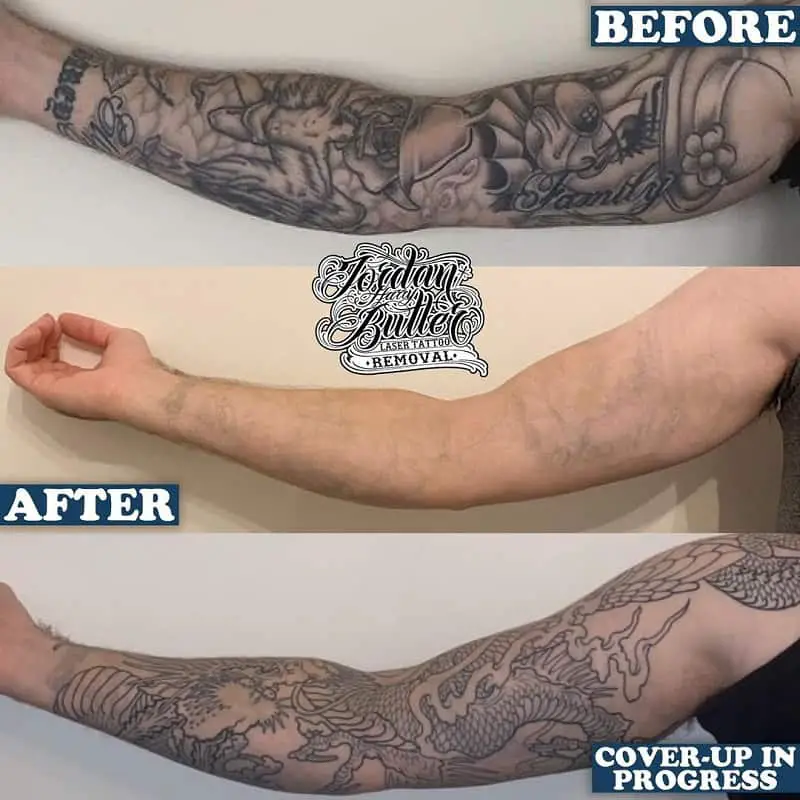Why You Need Multiple Sessions To Remove a Tattoo
It’s is truly unfortunate when you get a tattoo that you don’t like, or when it gets messed up due to an allergic reaction or infection. Luckily, there are many ways one can get rid of an unwanted tattoo, one of which is the laser tattoo removal method.
Laser removal is the best, and most widespread tattoo removal method that is notorious for a few things; it is expensive, and takes too damn long for the clients to start seeing actual tattoo fading and satisfying results.
But, why is that so? Isn’t the modern-day laser technology so advanced that it should take you only one session to get rid of a tattoo? That would be amazing actually, but the reality is far from that. Standard laser removal can take up to 10, even 15, expensive, painful laser treatment sessions.
In the following paragraphs, we’ll explore why does laser removal takes so much time to work and show results. So, if you’re interested, then just keep scrolling!
Laser Tattoo Removal – Quick Insight
Before we get into the reasons for the prolonged results of laser tattoo removal, we must first take a look at the laser machines and the process themselves.
First of all, laser tattoo removal is done using Q-switched lasers. These lasers use the photomechanical effect to target the ink, send infrared energy to heat the ink up, send shock waves and dissipate the ink into the skin. Here’s how the laser works exactly;
- The laser sends infrared light to the skin, where the light reached the tattoo pigment
- As a result, the ink absorbs the infrared light (different ink colors absorb the light differently as well)
- Then, the laser sends a pulse, or shock wave of energy to heat up the ink
- After the ink heats up, it starts to dissipate into the surrounding skin
As complicated as it sounds, these actions take a few seconds in real life, but unfortunately, one shock wave is not enough. The machine needs to send hundreds of these waves into the ink for you to even start noticing that it’s disappearing.
The reason for this is that the heat or energy waves must be short, otherwise, the laser could cause serious burning of the skin and the surrounding tissue. Alongside burning, there can also be scarring issues if the heat waves last too long.
Laser Tattoo Removal and Multiple Sessions – Explained

Why Does Laser Tattoo Removal Take So Long?
Laser tattoo removal can take anywhere between 10 and 25 sessions to get a tattoo fully or partially removed. These sessions cannot be done immediately; it takes some time between the sessions to ensure the skin recovers and build the immune defense against the upcoming removal sessions.
For a fully completed tattoo removal, you can expect it to last up to a year, in some cases even more. The number of sessions you will require depend heavily on your tattoo, the ink color or pigment, and the tattoo location.
So, why do you need so many sessions over such a long period of time?
Well, as we mentioned before, the standardized Q-switched lasers, which are currently the best for this type of procedure, heat up the ink to make it dissipate. The heat waves, if they last longer than required, can burn and scar the skin, which would cause irreparable damage.
Furthermore, the laser works together with your skin and body. Sometimes, the body doesn’t cooperate in terms of its ability to eliminate the ink or allow it to dissipate into the surrounding tissue.
The ink doesn’t get destroyed during the laser removal process; it just gets naturally removed from the body after the laser breaks it down into smaller particles or fragments. Without your skin’s or body’s cooperation, the laser will take more time to make everything work. This alone could count for a couple of additional removal sessions.
What Factors Affect the Number of Laser Removal Sessions?
It is important to know that laser tattoo removal won’t take the same amount of sessions for every type of tattoo. Some factors affect the number of sessions your particular tattoo requires. So, here are the main factors to take into consideration that could prolong your laser removal sessions;
- Your Lymphatic System
The lymphatic system is a network of tissues, organs, and vessels that work as a team to help your body get rid of all sorts of toxins, metabolic waste, and unwanted compounds and materials. However, the lymphatic system’s primary function is to move colorless liquid called lymph back into the bloodstream, or your circulatory system.
Thanks to this system, your body is able to transfer infection-fighting blood cells throughout the body. As a result, you’re able to fight off viruses, bacteria, infections, and inflammations, as well as different immune deficiencies.
Now, without this system, laser removal wouldn’t be possible. The network of tissues and vessels work together to remove the dissipated ink out of the body.
However, since the lymphatic system is already busy keeping your body healthy and going, it can take up to 2 months to process the ink as an additional toxins. In that period, the body starts recognizing the excess toxins and starts removing them. As a result, your tattoo starts to fade as well.
Now, if your immune system is impaired or if you’re sick, your lymphatic system might become overwhelmed with the additional toxins from the ink. The body prioritizes the organs or the sick system over some ink, so it might take longer for the system to get rid of dissipated ink. This, of course, can prolong the ink fading as well.
- Tattoo Location
The location of the tattoo can affect the laser removal duration significantly. Now, remember how the lymphatic system works? It removes toxins from the body using the bloodstream.
Well, if your tattoo is located somewhere where the blood flow is strong, the ink will dissipate quickly and the tattoo will fade faster. This means you might require fewer sessions.
The area where the blood flow is strong, is the chest or, to be more specific, the area close to your heart, for example. On the other hand, areas with weaker blood flow will require more sessions since the tattoo doesn’t fade as quickly. Such areas are generally feet and hands.
- Tattoo Ink Color/Pigment
Another important factor to consider in regards to laser removal is the color or the pigment of the tattoo. Some ink colors require less session because they absorb the heat energy better and quicker.
For example, darker pigments, like black, brown, or dark blue inks require fewer sessions. Black ink is the easiest to remove, while dark blue might be more difficult.
On the other hand, ink colors like yellow, bright red or bright orange require significantly more laser removal sessions. The reason is that these inks, because of their brightness, do not absorb the infrared light to the fullest, which makes the removal sessions prolonged.
- Tattoo Size
Now, this one is pretty obvious. The larger the tattoo, the more sessions it will take to get rid of all the ink. If a tattoo is large and contains colors like yellow, red, or orange, the removal might be even more difficult. Large tattoos may require up to 25 removal sessions, while brightly colored tattoos may require even more.
- Tattoo Health (Cases of Allergies and Infections)
Sometimes people who experience ink allergic reactions or tattoo infections end up with messed up, distorted tattoos. As a result, the tattoos don’t look good and may require complete removal.
Since the skin in the aftermath of allergic reaction/infection is damaged and sensitive, one may require multiple sessions to remove the remaining ink. In such cases, the remaining tattoo needs to heal completely, which might take months, and then the laser removal might take even longer to avoid burning and scarring of already damaged skin.
- Skin and Tattoo Age
New tattoos, which are fully healed, are the hardest to remove. They require the highest number of removal sessions. After a tattoo fully heals, one needs to wait at least a month or two before the laser removal, just to ensure there is no or minimum skin damage.
On the other hand, the older the skin, the harder it is to remove the tattoo. Older skin has less elasticity and is generally drier. It doesn’t bounce back and it overall more sensitive to laser treatments. To mitigate any potential skin damage, one may need multiple, but shorter laser removal sessions.
Note: Other things that might slow the laser removal process include having to wait between treatments, old laser technology, and inexperienced clinicians. Moreover, if a person lacks physical activity, smokes, and drinks alcohol regularly, chances are they’ll require additional removal sessions too. Poor immune system and sickness can also contribute to longer laser removal sessions.
Ways To Make The Laser Removal Process Faster
- Opt for laser removal clinics that require less resting intervals between laser removal sessions – These clinic use up-to-date lasers which do not damage the skin if the intervals between treatments are shorter. This can save you up to 2 to 4 weeks of waiting. However, such treatment could cost you more than regular laser removal.
- Opt for the best laser removal technology – Sure, this may cost you, but if you want to speed up the laser removal process, you’ll have to go to a clinic that uses fast picosecond lasers. These lasers treat all ink colors and are generally safe even for most sensitive skin types.
- Maintain a healthy lifestyle – The best thing you can do to speed up the laser removal process is to maintain a healthy lifestyle. Such a lifestyle comprises regular exercise, proper water intake, proper protein- and vitamin-rich nutrition, cessation of smoking, minimizing drinking, sunscreen use, etc.
Final Thoughts
Unfortunately, laser removal technology hasn’t advanced in the past few years. The number of sessions required to remove a tattoo is still pretty high. And, the side effects of the method, like pain or even skin damage/scarring, are still pretty possible, especially with untrained clinicians.
However, laser tattoo removal is currently the best, most effective option to get rid of unwanted ink. The price you have to pay for the process is well, time and money. But, at least, you’ll be free from the unwanted tattoo.
Also Read: How Many Laser Tattoo Removal Treatments Do I Need To Get Rid Of My Tattoo?
- Safe, non-toxic plant-based temporary tattoos made with 100% high-definition printing for a realistic look without the pain
- Easy to apply and remove - just stick for 20 seconds then take off
- Set includes 5 sheets with 17 fun, delicate designs like hearts, cats, smiles, suns, moons, and more
- Waterproof and long-lasting - stays on up to 2 weeks of wear
- Fashionable for women, men, girls and boys
- Place on arm, wrist, neck, leg, finger, waist, foot and more
- Great for parties, birthdays, and showing your unique style









